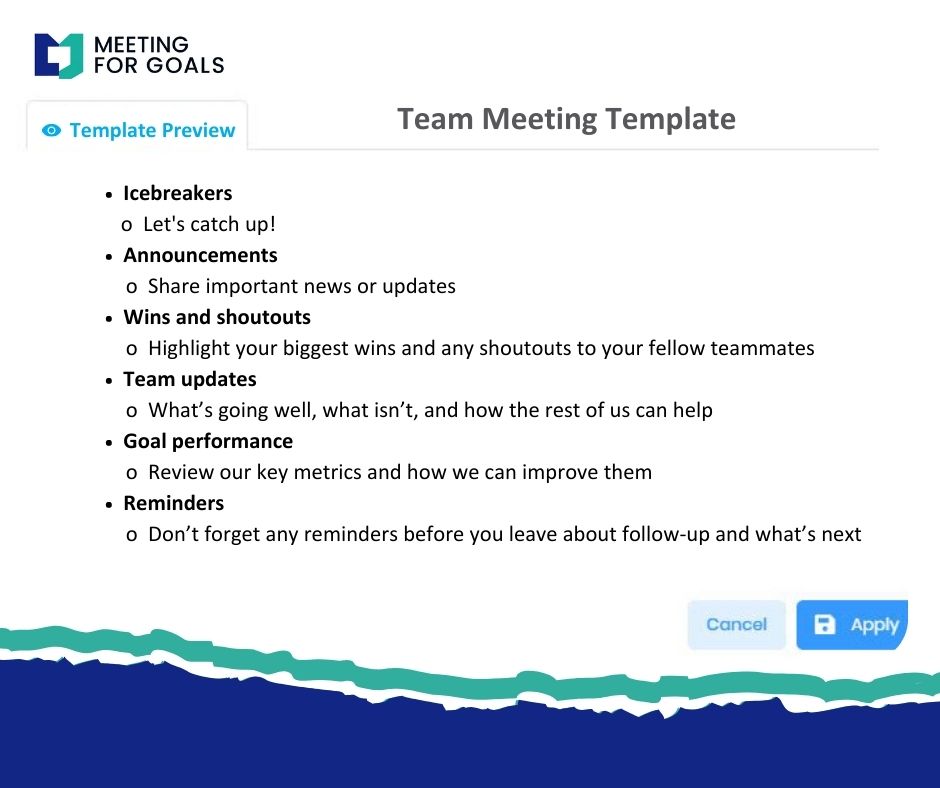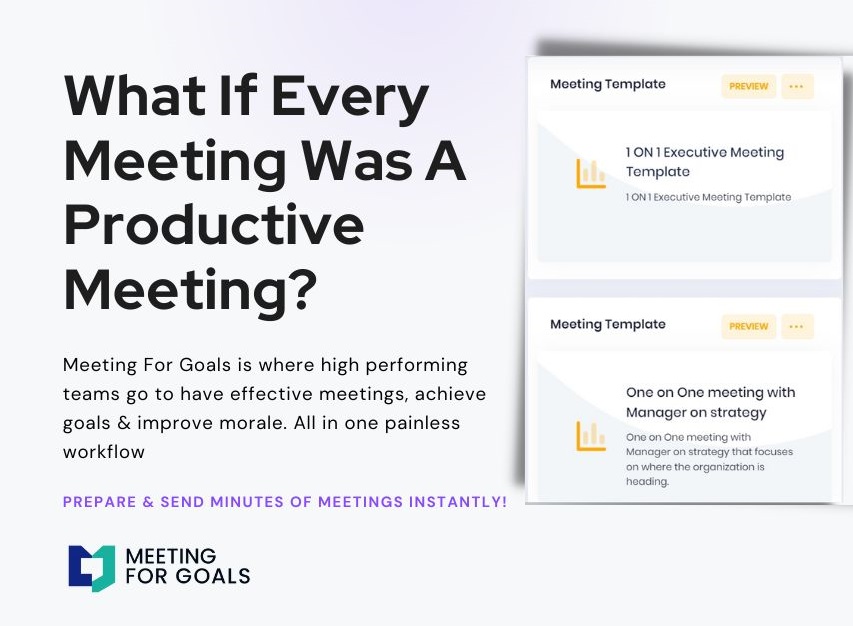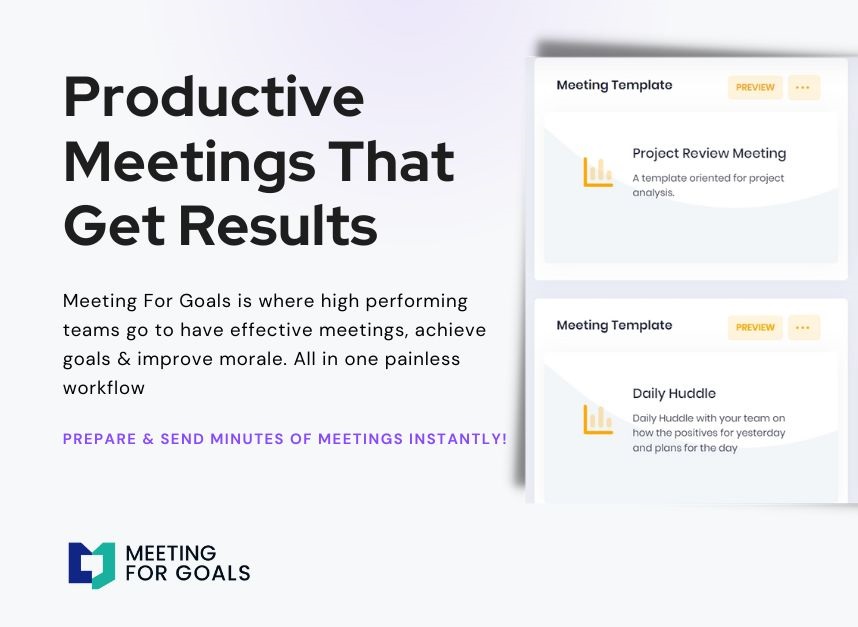Mastering Minute Taking: How to Capture Productive Meetings and Drive Team Success
Minute taking is more than just jotting down notes—it’s a powerful way to make meetings matter. For busy executives and high-performing teams, accurate and actionable meeting minutes can be the difference between a productive meeting and a wasted hour. In this blog, we’ll show you how effective minute-taking supports accountability, streamlines follow-ups, and enhances decision-making. We’ll also introduce you to Meeting For Goals—a tool that transforms meetings into strategic sessions. Whether you’re a C-suite leader or team director, this guide will help you unlock the full potential of your meetings through smarter minute-taking.
I. Introduction
In today’s fast-moving business world, meetings are where key decisions happen. But without clear documentation, even the most insightful discussion can be forgotten or misunderstood. That’s where minute taking comes in.
Minute taking is the process of recording what was discussed, what decisions were made, and who’s responsible for what. It keeps everyone on the same page and ensures that meetings lead to real progress.
For companies with 40–70 employees, especially those led by directors, VPs, and C-suite executives, clarity and accountability are essential. With multiple departments and fast-moving projects, it’s easy for important details to slip through the cracks.
- Minute taking helps bridge communication gaps.
- It ensures that meetings align with company goals.
Meeting For Goals is a meeting management platform built for teams that want to get more from their meetings. It helps you plan, capture, and follow through—so every meeting drives results. If you’re ready to bring more structure and purpose to your meetings, start by exploring our free meeting templates.
This guide will walk you through the benefits of effective minute taking, best practices, tools, and how Meeting For Goals can make your meetings more impactful. Whether you’re leading a product launch, managing a marketing team, or steering company strategy, you’ll learn how to turn meetings into a competitive advantage.
2 Minute Video
Watch a 2 minute demo of our meeting management software in action
II. The Role of Minutes in Meeting Effectiveness
Meeting minutes are more than a formality—they’re the record that keeps your team aligned and accountable.
At their core, minutes capture key discussions, decisions, and action items. They act as a reference point for what was said and what needs to happen next. This is especially important in fast-paced environments where multiple projects are running at once.
For executives, minutes offer a clear snapshot of progress. They show:
- Who’s responsible for what.
- What deadlines are approaching.
- How team efforts are aligning with broader goals.
When used consistently, minutes reduce confusion and help avoid redundant conversations. One of the most important roles of meeting minutes is documenting action items. These are specific tasks assigned during the meeting—who’s doing what and by when. When shared promptly after the meeting, these notes keep momentum going and ensure follow-up.
Minutes also serve as a roadmap for future meetings. They help teams:
- Track progress.
- Revisit decisions.
- Stay focused.
For example, if your product team discussed a new feature rollout, the minutes would note the plan, deadlines, and next steps. At the next meeting, you can check in on that progress and adjust as needed.
Minutes also support strategic alignment. By linking meeting discussions to company goals, your team stays focused on what matters most. This is especially important for leadership teams that need to ensure every department is pulling in the same direction.
Meeting For Goals simplifies this entire process. It automatically captures decisions, action items, and deadlines—and aligns them with your organizational goals. No more scattered notes or forgotten tasks. Everything is captured in one place, ready to be acted on.
Want to see how this works in real time? Sign up here and start transforming your meetings today.
Adding an Agenda
How to add an agenda instantly on Meeting For Goals
III. Best Practices for Effective Minute Taking
Great minutes don’t happen by accident. They start with good preparation and follow a clear structure. Here’s how to do it right.
A. Preparation Before the Meeting
- Set a Clear Agenda: A solid agenda is your roadmap. It outlines what will be discussed, what the goals are, and how much time is allocated to each topic. This not only keeps the meeting on track but also helps the minute taker know what to focus on.
- Meeting For Goals makes agenda planning easy. You can create and share agendas ahead of time so everyone comes prepared. Explore our free meeting templates to get started.
- Assign a Dedicated Minute Taker: Choose someone to take minutes before the meeting begins. Ideally, this person should not be actively participating in the discussion. Their role is to listen, capture key points, and ensure nothing important is missed.
B. What to Capture During the Meeting
- Key Discussions and Contributions: Don’t try to write down every word. Focus on key decisions, important discussions, and strategic insights. Summarize what was said and why it matters.
- Action Items with Deadlines: Every task should be clearly documented. Note who is responsible, what needs to be done, and when it’s due. This creates accountability and a clear path forward.
C. Structuring Minutes for Clarity
A well-structured document is easy to read and reference. Include:
- Meeting title and date
- List of attendees
- Agenda items
- Key decisions and discussion points
- Action items with owners and due dates
- Date of next meeting (if scheduled)
Meeting For Goals automates much of this. It captures action items in real-time, assigns tasks, and syncs with your project management tools.
Effective minute taking turns meetings into action plans. By following these best practices, you’ll ensure your team stays aligned, focused, and productive.
IV. Tools and Techniques for Streamlined Minute Taking
Let’s face it—pen and paper just don’t cut it anymore. Today’s teams need tools that help capture, organize, and follow up on meeting insights.
A. Using Meeting For Goals
Meeting For Goals is built to make minute taking seamless. Here’s how:
- Real-Time Capture: It allows users to create agendas, take notes, and assign action items in real-time. No more scrambling to remember what was said.
- Templates and Standardization: Use built-in templates to keep your minutes consistent across teams. This saves time and ensures nothing gets missed.
- Integration with Other Tools: Connect Meeting For Goals with your calendar, task manager, and communication tools. Everything stays in sync, and your team stays on track.
- Automatic Follow-Up: Minutes are automatically shared after the meeting, complete with action items and reminders. No more chasing people down.
B. Alternative Tools
Not ready for a full meeting management platform yet? Here are some alternatives:
- Google Docs: Great for real-time collaboration.
- Microsoft OneNote: Good for organizing structured notes.
- Evernote: Useful for searchable archives.
- Otter.ai: Transcribes meetings automatically.
These tools can help, but they often require manual follow-up. They also lack the goal alignment and accountability features that Meeting For Goals offers.
C. Integrating Tools into Your Workflow
Wherever your minutes live, they should connect to your workflow. Meeting minutes should feed into your task lists, project plans, and performance reviews. That’s where Meeting For Goals really shines—it brings everything together in one place.
Explore how Meeting For Goals can help you streamline your workflow and boost team productivity.
V. Common Challenges in Minute Taking and How to Overcome Them
Even experienced teams run into minute-taking challenges. Here’s how to tackle the most common ones.
A. Distractions and Off-Topic Conversations
Meetings can jump from topic to topic, making it hard to keep up. A structured agenda helps keep things on track. Meeting For Goals helps by guiding the meeting flow and keeping everyone focused.
B. Vague Discussions and Jargon
Sometimes, discussions are unclear or filled with technical terms. If something isn’t clear, the minute taker should ask for clarification or summarize back to the group. This ensures everyone is aligned.
Meeting For Goals allows real-time collaboration, so team members can refine notes together during the meeting.
C. Lack of Follow-Up
Minutes are only useful if people act on them. Assign action items during the meeting and send out the minutes immediately after. Meeting For Goals automates this, ensuring that tasks don’t fall through the cracks.
D. Inconsistent Formatting
When minutes look different every time, they’re hard to read and track. Use templates to keep things consistent. Meeting For Goals includes customizable templates that make this easy.
By addressing these challenges head-on, you’ll create a minute-taking process that supports real progress and accountability.
VI. Real-World Benefits of Effective Minute Taking
Let’s look at how strong minute-taking practices impact real teams.
- Better Accountability: When tasks are clearly assigned and deadlines are documented, it’s easier to hold people accountable. No one can say, “I didn’t know I was supposed to do that.”
- Improved Team Alignment: Minutes help teams stay aligned on goals, especially when multiple departments are involved. Everyone knows what was decided and what comes next.
- Faster Decision-Making: With clear records of past decisions, teams don’t waste time rehashing old discussions. They can move forward confidently.
- Stronger Strategic Focus: Linking minutes to company goals ensures that meetings stay focused on what matters most. Teams can see how their work contributes to the bigger picture.
According to a study by Harvard Business Review, structured meetings with clear documentation result in 30% faster project execution. That’s a powerful return on investment for something as simple as taking better notes.
VII. Conclusion
Effective minute taking is more than just good housekeeping—it’s a strategic tool for driving team success.
By preparing in advance, capturing key insights, and using the right tools, you can turn every meeting into a productive session that moves your business forward. Meeting For Goals makes this easy by integrating agendas, action tracking, and goal alignment into one seamless platform.
If you’re a director, VP, or C-suite leader looking to get more from your meetings, it’s time to rethink how you approach minute taking.
Start by exploring our free meeting templates or sign up here to try Meeting For Goals today.
For more tips on running smarter, more effective meetings, visit our website.
—
Ready to take your meetings to the next level? Visit https://meetingforgoals.com and start transforming your meeting culture today.



